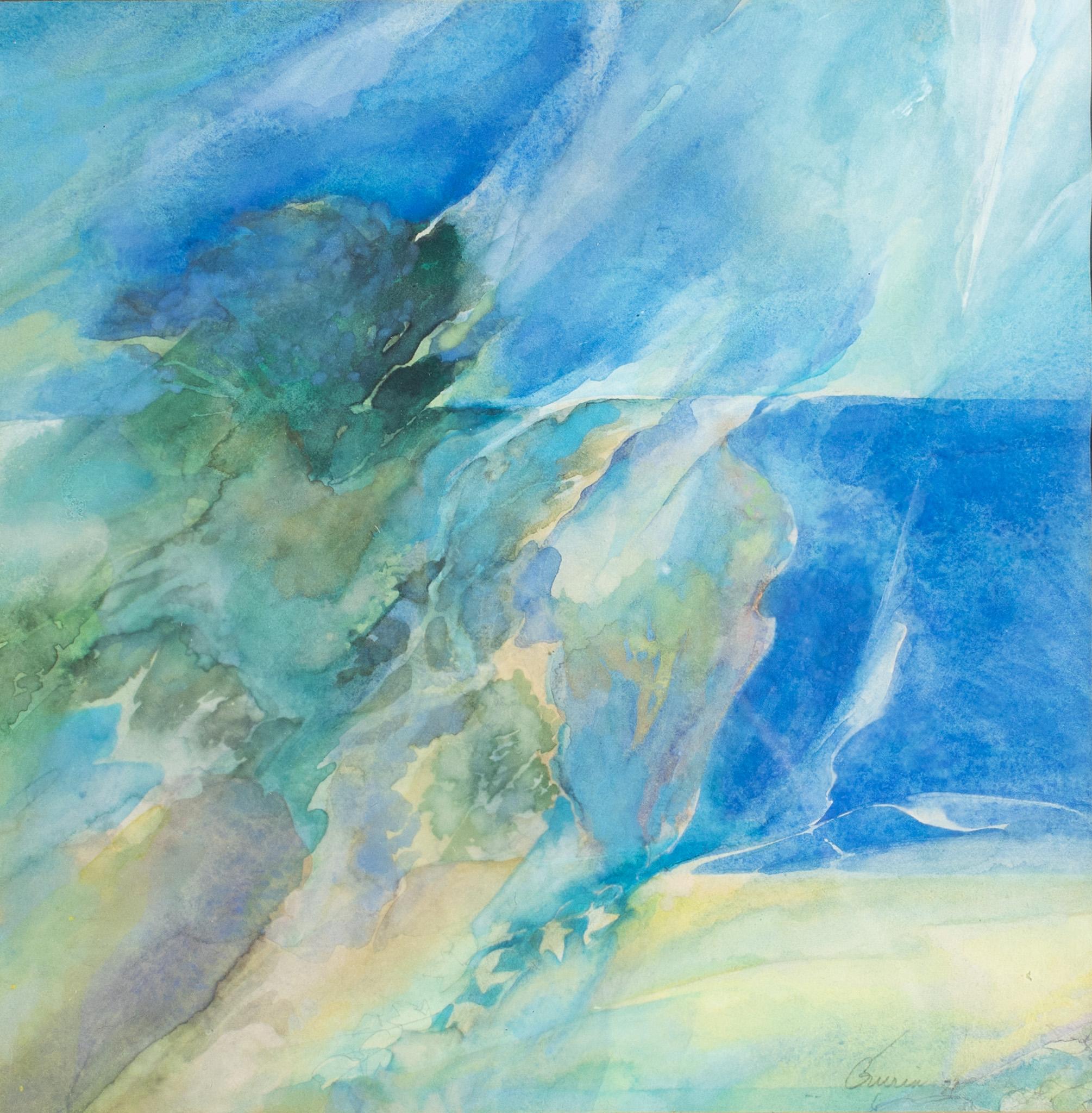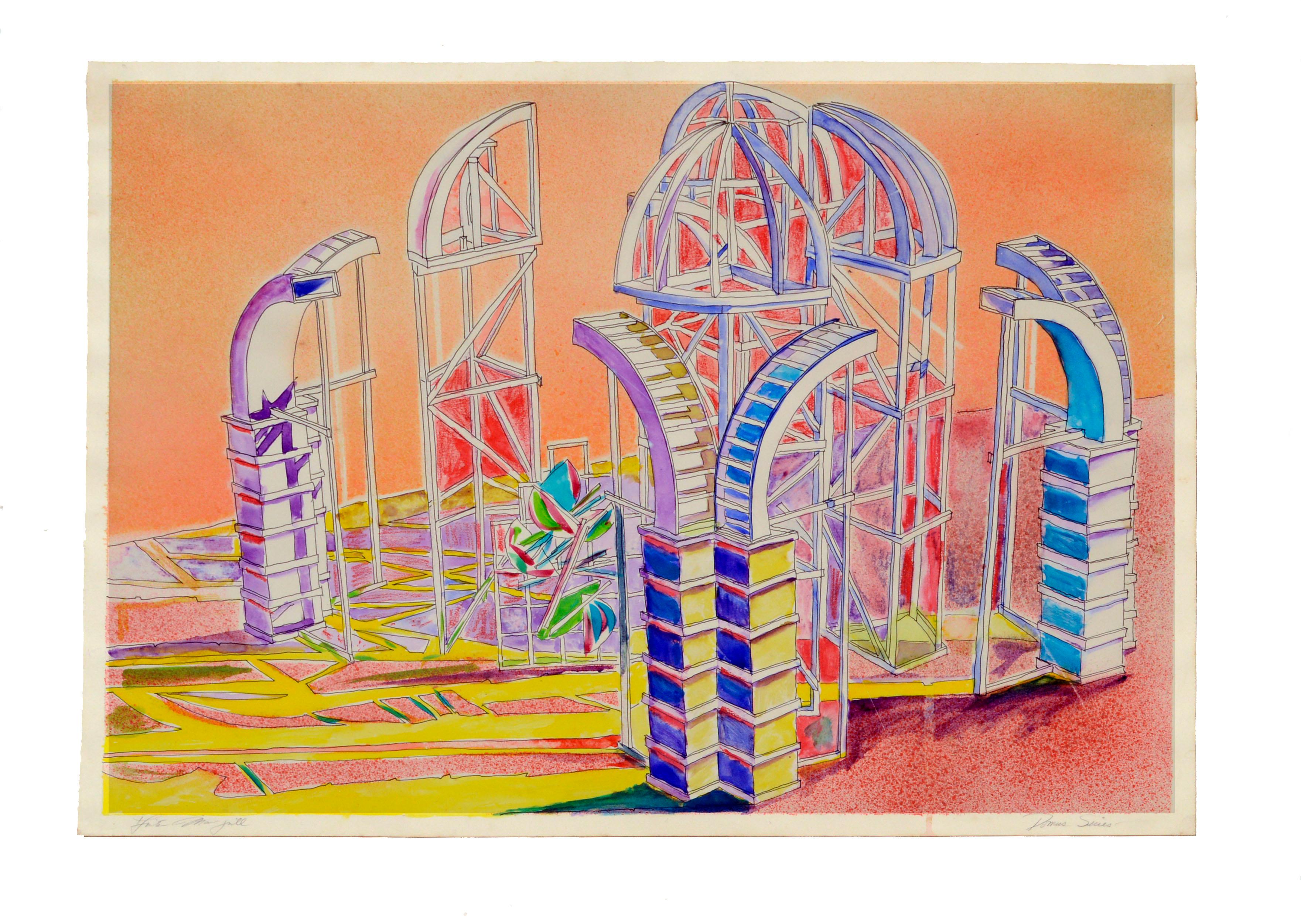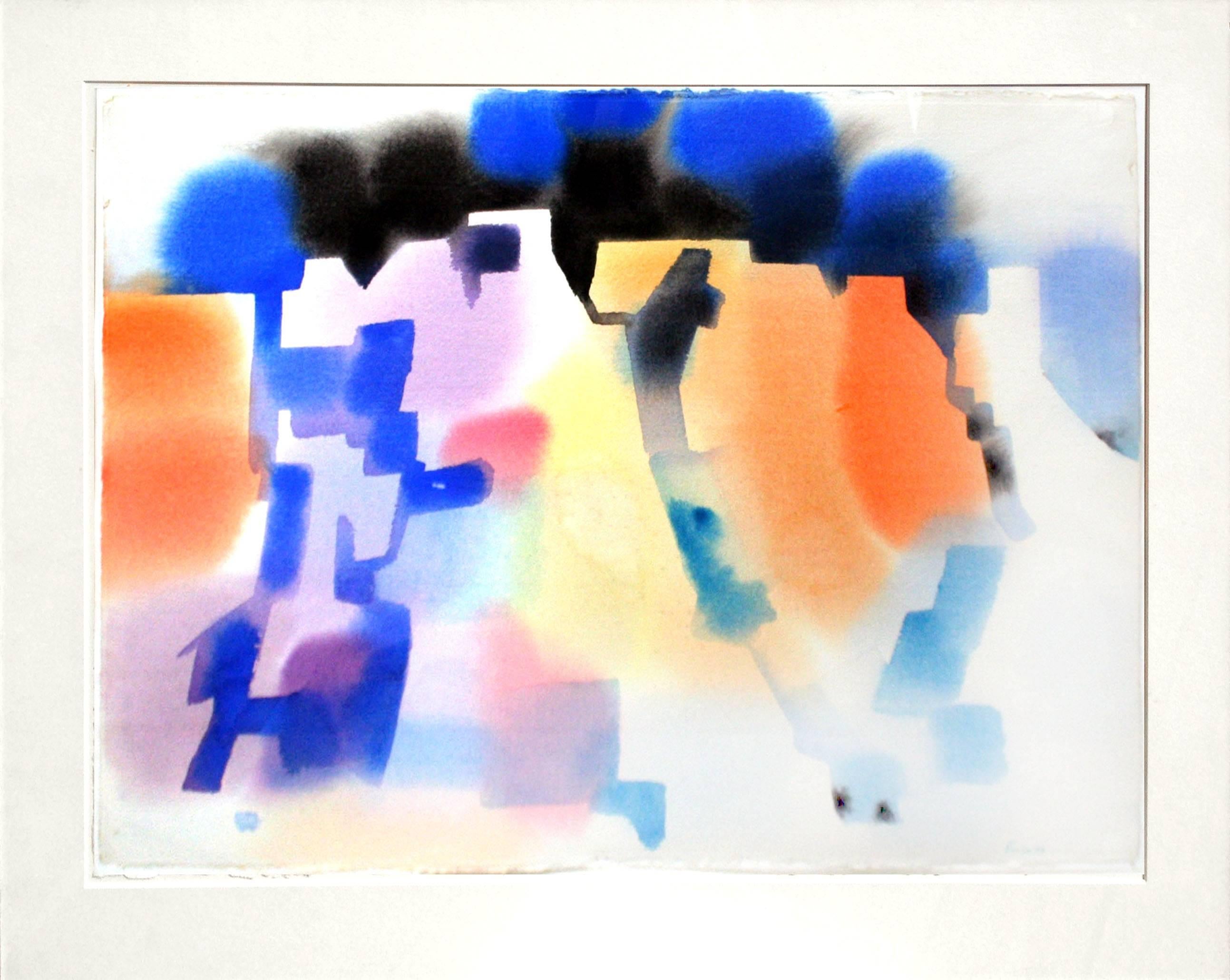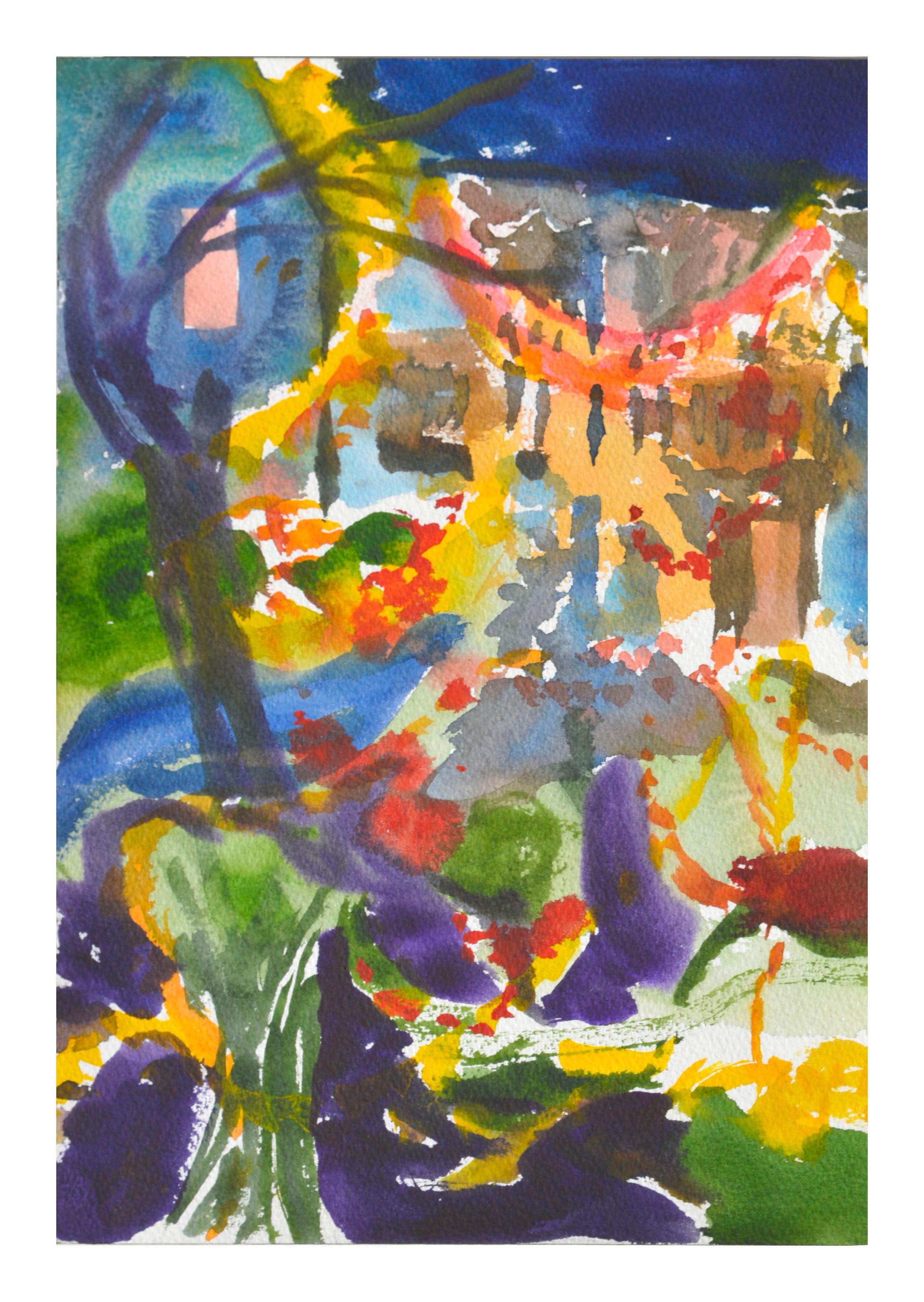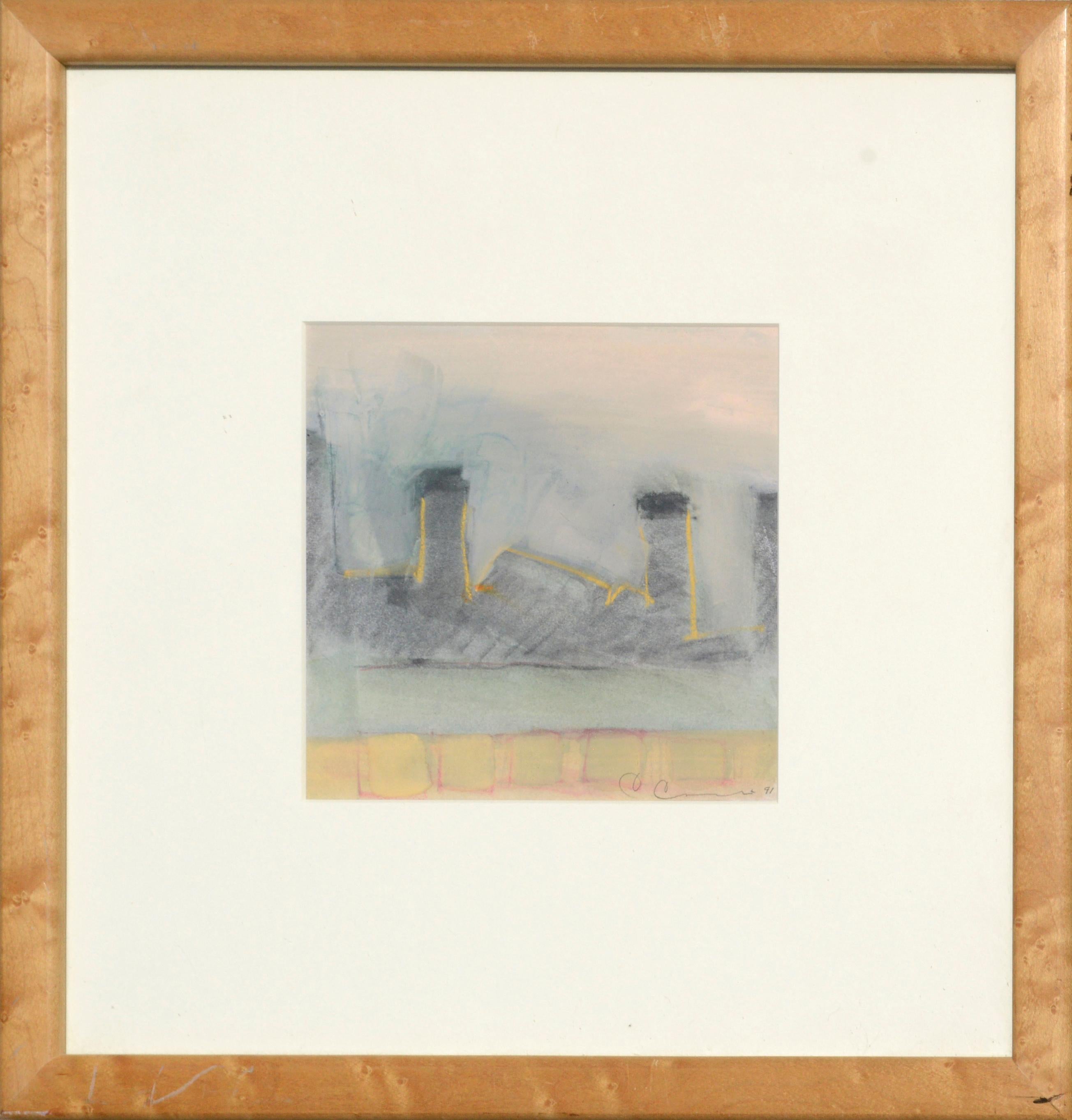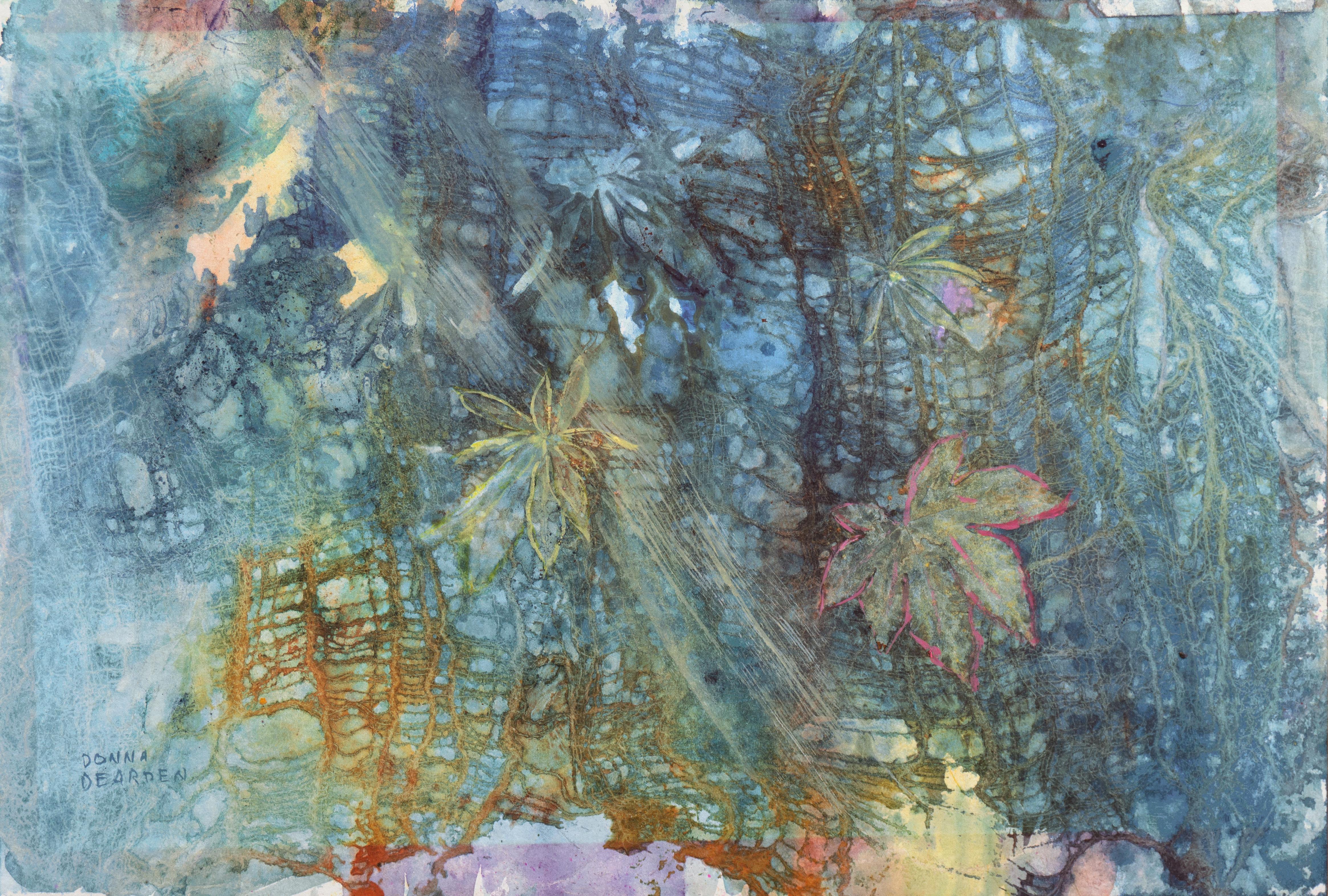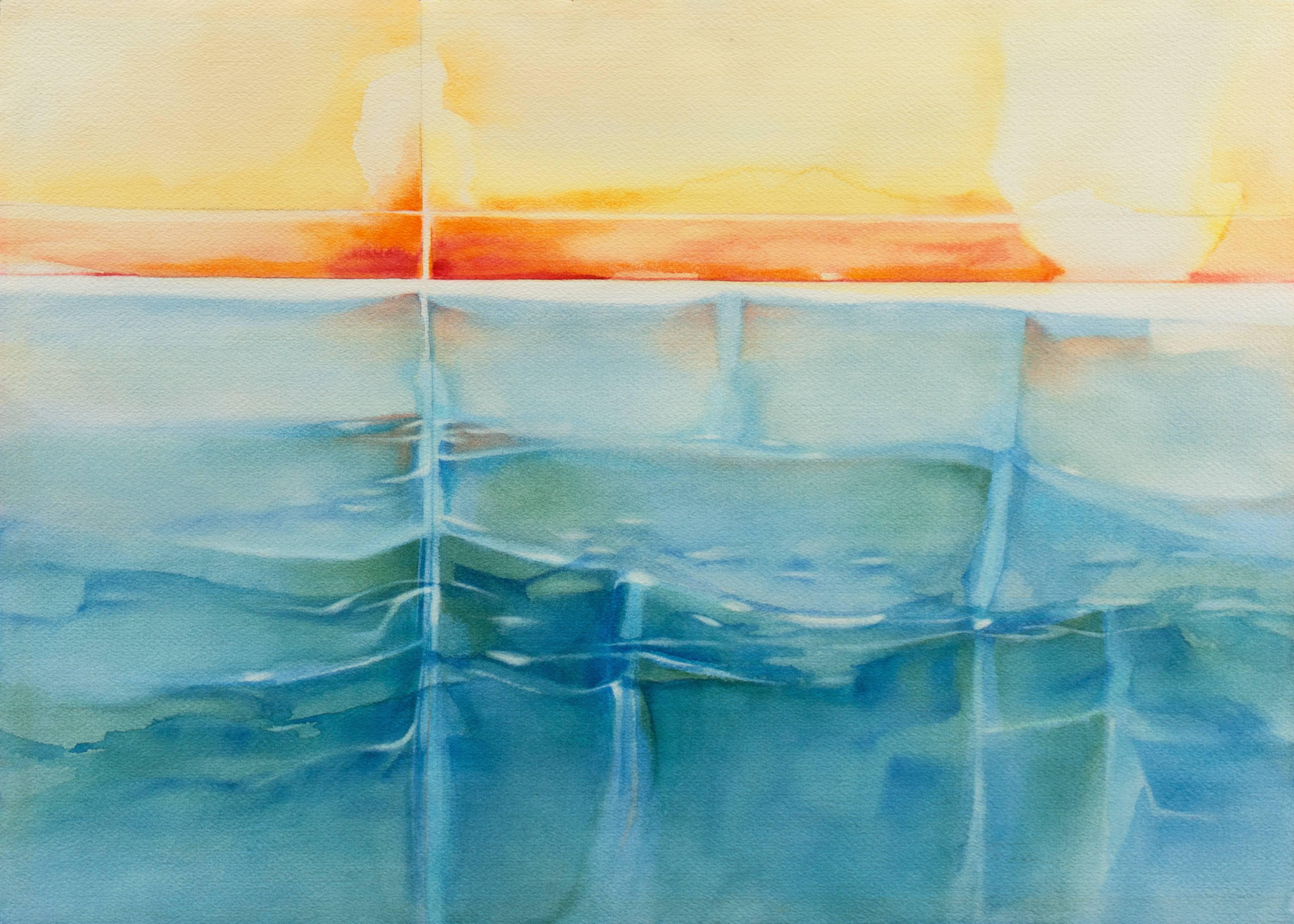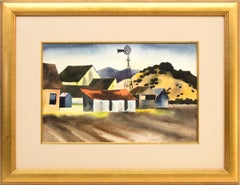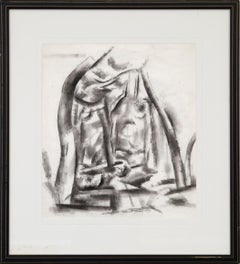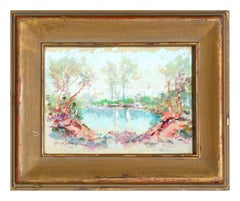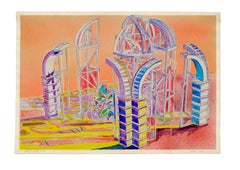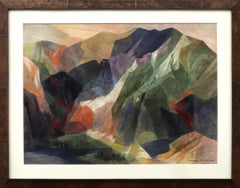
Dawn, Semi-Abstract Mountain Landscape, Multi-colored Watercolor Painting
View Similar Items
Video Loading
Want more images or videos?
Request additional images or videos from the seller
1 of 19
Ethel MagafanDawn, Semi-Abstract Mountain Landscape, Multi-colored Watercolor Painting
About the Item
- Creator:Ethel Magafan (1916-1993, American)
- Dimensions:Height: 28.5 in (72.39 cm)Width: 36.5 in (92.71 cm)Depth: 1.5 in (3.81 cm)
- Medium:
- Movement & Style:
- Period:
- Framing:Frame IncludedFraming Options Available
- Condition:
- Gallery Location:Denver, CO
- Reference Number:Seller: 265021stDibs: LU27310798382
Ethel Magafan
Ethel Magafan Born Illinois, 1916
Died New York, 1993 Jenne and Ethel Magafan were identical twins, born in Chicago to a Greek immigrant father and a Polish mother. Due to health concerns about their father, the family moved to Colorado, living first in Colorado Springs and then in Denver. He was a proud supporter of their artistic ambitions but died suddenly 1932, a heavy blow to both of them. They attended East High School in Denver, where they found a mentor in their art teacher Helen Perry. She had studied at the Art Institute of Chicago but had later abandoned a career as an artist, making her all the more determined to help the Magafan twins succeed artistically. While still in high school, the twins impressed artist Frank Mechau, and Helen Perry paid for their lessons with him. He subsequently invited them to apprentice with him at his Redstone studio. In 1936, Jenne won the Carter Memorial Art Scholarship and shared it with her sister so that they both could attend the Broadmoor Art Academy in Colorado Springs. Once they ran out of money, Mechau, now teaching there, hired them as assistants. Through their involvement at the Academy, the twins entered into careers as muralists, working at first with Mechau and then with Peppino Mangravite. From 1937 to 1943, Ethel was commissioned to paint her first of seven government sponsored murals. Located in the US Post Office in Auburn, Nebraska, this commission made Ethel (at age 26) the youngest artist in America to receive such an honor. Denver Art Museum director Donald J. Bear once commented that “[Ethel and Jenne's] study of local detail makes them appear as little Bruegels of ranch genre – natural and unforced.” As mural painting commissions diminished, Ethel began to do more easel painting for which she used a palette knife and tempera paints to great effect. After settling in California for five years, the twins permanently relocated to Woodstock, New York in 1945, where the sisters lived apart for the first time. Ethel developed an increasing focus within her work, particularly for horses and abstract landscapes. She met fellow artist Bruce Currie at an artist’s party, and the two were married in 1946. The twins and their husbands went to Greece and Italy for a year when Jenne’s husband and Ethel were granted Fulbright Scholarships. Upon their return, Jenne died suddenly of a cerebral hemorrhage — a loss that Ethel would mourn deeply. With her sister gone, her landscapes became much more abstract, as she sought out the feeling of the scene rather than an exact representation. During the mid-fifties, she began to make annual trips to Colorado. Her stature within the art world was solidified in 1971 when the United States ©David Cook Galleries, LLC
About the Seller
5.0
Platinum Seller
These expertly vetted sellers are 1stDibs' most experienced sellers and are rated highest by our customers.
Established in 1979
1stDibs seller since 2013
265 sales on 1stDibs
Typical response time: 3 hours
More From This SellerView All
- Gold Mining, Homestake Mine, South Dakota, 1940s Abstract Landscape WatercolorLocated in Denver, COGouache and watercolor on paper painting, painted in 1948 by Mary Chenoweth (1918-1999). Signed and dated by the artist in the lower right corner. Depicting an abstracted landscape o...Category
1940s Abstract Abstract Drawings and Watercolors
MaterialsWatercolor, Gouache, Archival Paper
- 1930s American Farm Scene, Landscape Watercolor Painting Farm Buildings WindmillBy Samuel Bolton ColburnLocated in Denver, COOriginal watercolor on paper painting by Samuel Bolton Colburn (1909-1993) of a small farm situated in a valley near the mountains. Presented in a custom frame, outer dimensions meas...Category
1930s American Modern Landscape Drawings and Watercolors
MaterialsPaper, Watercolor
- Early 20th Century Black White Abstracted Landscape Charcoal DrawingBy Willard Ayer NashLocated in Denver, CO"Abstract" is a charcoal on paper drawing by Willard Ayers Nash (1898-1942) of an abstracted landscape scene. Presented in a custom black frame measuring 22 x 20 x ¾ inches. Image size measures 14 ½ x 12 ¾ inches. Drawing is clean and in very good condition - please contact us for a detailed condition report. Expedited and international shipping is available - please contact us for a quote. About the Artist: Willard Ayer Nash Born Philadelphia, Pennsylvania, 1897 Died Albuquerque, New Mexico, 1942 Biography courtesy of Owings-Dewey Fine Art Willard Nash was frequently referred to as “the American Cézanne”. Like the French Post-Impressionist Cézanne, Nash created form with color and did wonderful work with shadows. Prior to his arrival in New Mexico, Nash painted in a formal, academic style that he learned while studying at the Detroit School of Fine Arts. However, under the tutelage of Andrew Dasburg, a fellow Santa Fe...Category
Early 20th Century Abstract Abstract Drawings and Watercolors
MaterialsPaper, Charcoal
$3,088 Sale Price34% Off - The Cliff, Abstract Colorado Landscape, American Modernist Pastel DrawingBy Eric BransbyLocated in Denver, COAbstract Colorado mountain landscape by Eric James Bransby (1916-2020). Pastel on paper in colors of green, orange, blue, and purple. Presented in a custom frame with archival materi...Category
1990s Abstract Abstract Drawings and Watercolors
MaterialsOil Pastel, Pastel, Archival Paper
$3,800 Sale Price20% Off - Georgetown (Church in the Mountains, Colorado), Modernist Landscape Ink DrawingBy Charles Ragland BunnellLocated in Denver, COGeorgetown, Colorado, vintage 1938 WPA era ink drawing/painting on paper of a church set in a rocky mountain landscape by Charles Bunnell (1897-1968). Black on a creamy white paper, signed and dated lower right, titled lower left. Presented in a custom frame with all archival materials, outer dimensions measure 16 ¼ x 14 ½ x 1¼ inches. Image size is 7 ¾ x 5 ¾ inches. Drawing is clean and in good vintage condition - please contact us for a detailed condition report. Provenance: Estate of Charles Ragland Bunnell Expedited and international shipping is available - please contact us for a quote. About the Artist: Charles Bunnell developed a love for art as a child in Kansas City, Missouri. Around 1915, Bunnell moved with his family to Colorado Springs, Colorado. He served in World War I and later used his GI Training to study at the Broadmoor Art Academy (later renamed the Colorado Springs Fine Arts Center) during 1922 and 1923. In 1922, he married fellow student, Laura Palmer...Category
1930s American Modern Landscape Drawings and Watercolors
MaterialsInk, Archival Paper
- A Small City Park, Abstract Painting Acrylic Watercolor Painting, Green BrownBy Edward MarecakLocated in Denver, CO"A Small City Park", acrylic and watercolor on paper by Denver artist Edward Marecak (1919-1993) of an abstract park broken into four quadrants, separated by brown and white striped borders with different shaped ponds. Inspired by City Park in Denver, Colorado where the artist frequented. Presented framed with all archival materials, outer dimensions measure 21 ¾ x 18 ¾ inches. Image size measures 12 x 15 inches. Painting is clean and in good condition - please contact us for a detailed condition report. Provenance: Estate of Edward Marecak Expedited and international shipping is available - please contact us for a quote. About the Artist: Born to immigrant parents from the Carpathian region in Slovakia, Marecak grew up with his family in the farming community of Bennett’s Corners, now part of the town of Brunswick, near Cleveland, Ohio. When he turned twelve, his family moved to a multi-ethnic neighborhood of Poles, Czechs, Slovaks and Slovenians in Cleveland. His childhood household cherished the customs and Slavic folk tales from the Old Country that later strongly influenced his work as a professional artist. During junior high he painted scenery for puppet shows of "Peter and the Wolf," awakening his interest in art. In his senior year in high school he did Cézanne-inspired watercolors of Ohio barns at seventy-five cents apiece for the National Youth Administration. They earned him a full scholarship to the Cleveland Institute of Art (1938-1942) where he studied with Henry George Keller whose work was included in the 1913 New York Armory Show. In 1940 Marecak also taught at the Museum School of the Cleveland Institute. Before being drafted into the military in 1942, he briefly attended the Cranbrook Academy of Art near Detroit, one of the nation’s leading graduate schools of art, architecture, and design. A center of innovative work in architecture, art and design with an educational approach built on a mentorship model, it has been home to some of the world’s most renowned designers and artists, including Eero Saarinen, Charles Eames, Daniel Libeskind and Harry Bertoia. Marecak’s studies at Cranbrook with painter Zoltan Sepeshy and sculptor Carl Milles were interrupted by U.S. army service in the Aleutian Islands during World War II. Following his military discharge, Marecak studied on the G.I. Bill at the Colorado Springs Fine Arts Center from 1946 to 1950, having previously met its director, Boardman Robinson, conducting a seminar in mural painting at the Cleveland Institute of Art. Although he did not work with Robinson at the Fine Arts Center, who had become quite ill - retiring in 1947 - he studied Robinson’s specialty of mural painting before leaving to briefly attend the Cranbrook Academy in 1947. That same year he returned to the Fine Arts Center, studying painting with Jean Charlot and Mary Chenoweth, and lithography with Lawrence Barrett with whom he produced some 132 images during 1948-49. At the Fine Arts Center he met his future wife, Donna Fortin, whom he married in 1947. Also a Midwesterner, she had taken night art courses at Hull House in Chicago, later studying at the Art Institute of Chicago with the encouragement of artist Edgar Britton. After World War II she studied with him from 1946 to 1949 at the Fine Arts Center. (He had moved to Colorado Springs to treat his tuberculosis.) Ed Marecak also became good friends with Britton, later collaborating with him on the design of large stained glass windows for a local church. In 1950-51 Marecak returned to the Cleveland Institute of Art to complete his Bachelor of Fine Arts degree. A year later he was invited to conduct a summer class at the University of Colorado in Boulder, confirming his interest in the teaching profession. In 1955 he received his teaching certificate from the University of Denver. Vance Kirkland, the head of its art department, helped him get a teaching job with the Denver Public Schools so that he and his family could remain in the Mile High City. For the next twenty-five years he taught art at Skinner, Grove, East, George Washington and Morey Junior High Schools. Prior to coming to Colorado, Marecak did watercolors resembling those of Winslow Homer, John Singer Sargent and Charles Burchfield. However, once in Colorado Springs he decided to destroy much of his earlier ouevre, embarking on a totally new direction unlike anything he had previously done. Initially, in the 1940s he was influenced by surrealist imagery and Paul Klee, and in the West by Indian petroglyphs and Kachinas. His first one-person show at the Garrett Gallery in Colorado Springs in 1949 featured paintings and lithographs rendered in the style of Magic Realism and referential abstraction. The pieces, including an oil Witch with Pink Dish, foreshadowed the output of his entire Colorado-based career, distinguished by a dramatic use of color, intricacy of execution and attention to detail contributing to their visual impact. He once observed, "Each time I start a new painting I always fool myself by saying this time keep it simple and not get entangled with such complex patterns, color and design; but I always find myself getting more involved with richness, color and subject matter." An idiosyncratic artist proficient in oil, acrylic, watercolor, gouache and casein, he did not draw upon Colorado subject matter for his work, unlike many of his fellow painters in the state. Instead he used Midwest landscape imagery, bringing to life in it witches and spirits adapted from the Slovakian folk tales he heard growing up in Ohio. A number of his paintings depict winter witches derived from the Slovak custom in the Tatra Mountains of burning an effigy of the winter witch in the early spring to banish the memory of a hard winter. The folk tale element imparts a dream-like quality to many of his paintings. A devote of Greek mythology, he placed the figures of Circe, Persephone, Sybil, Hera and others in modern settings. The goddess in Persephone Brings a Pumpkin to her Mother, attired as a Midwestern farmer’s daughter, heralds the advent of fall with the pumpkin before departing to spend the winter season in the underworld. Train to Olympus, the meeting place of the gods in ancient Greece, juxtaposes ancient mythology with modernity creating a combination of whimsy and thought-provoking consideration for the viewer. Voyage to Troy #1 alludes to the ancient city that was the site of the Trojan Wars, but has a contemporary, autobiographical component referencing the harbor of the Aleutian Islands recaptured from the Japanese during World War II. In the 1980s Marecak used the goddess Hera in his painting, Hera Contemplates Aspects of the Art Nouveau, to comment on art movements in the latter half of the twentieth century Marecak’s love of classical music and opera, which he shared with his wife and to which he often listened while painting in his Denver basement studio, is reflected in Homage of Offenbach, an abstract work translating the composer’s musical colors into colorful palette. Pace, Pace, Mio Dio, the title of his earliest surrealist painting, is a soprano aria from Verdi’s opera, La Forza del Destino (The Force of Destiny or Fate, a favorite Marecak subject). His Queen of the Night relates to a character from Mozart’s opera, The Magic Flute. In addition to paintings and works on paper, he produced hooked rugs, textiles and ceramics. He likewise produced designs for ceramics, tableware and furniture created by his wife Donna, an accomplished Colorado ceramist. Both of them generally eschewed exhibitions and galleries, preferring to quietly do their work while remaining outside of the mainstream. He initially exhibited at the Colorado Springs Fine Arts Center in 1948 receiving a purchase award. The following year he had his first one-person show of paintings and lithographs at the Garrett Gallery in Colorado Springs. In the 1950s and early 1960s he participated in group exhibitions at the Print Club (Philadelphia); Amarillo Public Library (Texas); annual Blossom Festival Show (Canon City, Colorado); Adele Simpson’s "Art of Living" in New York; Denver Art Museum; and the Fox Rubenstein-Serkey Gallery (Denver); but he did not have another one-person show until 1966 at the Denver home of his friends, John and Gerda Scott. They arranged for his first one-person show outside of Colorado held two years later at the Martin Lowitz Gallery in Beverly Hills and Palm Springs, California. That same year his work was featured at the Zantman Galleries in Carmel, California. Thereafter he became an infrequent exhibitor after the 1970s so that his work was rarely seen outside his basement studio. In 1980 he, his wife and Mark Zamantakis exhibited at Denver’s Jewish Community Center, and four years later he had a one-person show at the Studio Gallery in Denver. In 1992 he was included in a group show at the Rule Modern and Contemporary Gallery in Denver, and a year later received a large, posthumous retrospective at the Emmanuel...Category
Mid-20th Century Abstract Abstract Paintings
MaterialsPaper, Acrylic, Watercolor
You May Also Like
- "Abstract Landscape" Watercolor PaintingBy John GuerinLocated in Austin, TXAbstract landscape resembling a blue, green, yellow, and white. This piece is painted with watercolor and measuring 13" x 13". The frame measures 22" x 24".Category
1970s Abstract Abstract Drawings and Watercolors
MaterialsWatercolor, Archival Paper
- Early 20th Century Fauvist Abstracted LandscapeBy Charles Henry HarmonLocated in Soquel, CAA colorful, expressive fauvist watercolor landscape of a pond in the forest (Pan Pacific Exposition Palace Ruins) by Charles Henry Harmon(American, 1895-1936). Presented in a giltwoo...Category
1920s Abstract Impressionist Landscape Drawings and Watercolors
MaterialsPaper, Watercolor
$1,200 Sale Price20% Off - "Domus Series" - Abstract Geometric Futuristic Neon LandscapeLocated in Soquel, CAA bright neon futuristic geometric landscape, depicting a detailed imaginative deconstructive dome structure in a polychrome world, titled "Domus Series" by Anita Margrill (American,...Category
1980s Abstract Geometric Landscape Drawings and Watercolors
MaterialsWatercolor, Archival Paper
$2,280 Sale Price20% Off - Wyoming Mountains, Modern Abstract Geometric Landscape WatercolorBy Erle LoranLocated in Soquel, CAWyoming Mountains, Modern Abstract Geometric Landscape Watercolor Energetic modern abstract watercolor in blue and orange hues, by Erle Loran (Ame...Category
1980s Abstract Expressionist Abstract Drawings and Watercolors
MaterialsPaper, Watercolor
- Abstract Landscape WatercolorBy Les AndersonLocated in Soquel, CAAbstract watercolor with loosely defined landscape elements by Les (Leslie Luverne) Anderson (American, 1928-2009). From the estate of Les Anderson in Monterey, California. Signed on...Category
1980s Abstract Expressionist Abstract Drawings and Watercolors
MaterialsPaper, Watercolor
$223 Sale Price20% Off - Abstract Cityscape WatercolorBy Les AndersonLocated in Soquel, CAAbstract cityscape watercolor with loosely defined landscape elements and geometric shapes by Les (Leslie Luverne) Anderson (American, 19...Category
1980s Abstract Expressionist Abstract Drawings and Watercolors
MaterialsPaper, Watercolor
$223 Sale Price20% Off
Recently Viewed
View AllMore Ways To Browse
Watercolor Floral Dress
Picasso Poster 1950s
Matisse Print Dancer
Tiffany Locations
Tiffany Location
No Post No Bills
Notre Dame Paris 1950s
Drawing Vintage Cowboy Art
Polish War Poster
Public Health Posters
Dior So Real Blue
New York State Travel Poster
Retro Western Dresses
Indian Floral Painting
New Orleans Poster
Duncan Grant
Polished Cotton Dresses
Holland America Poster
